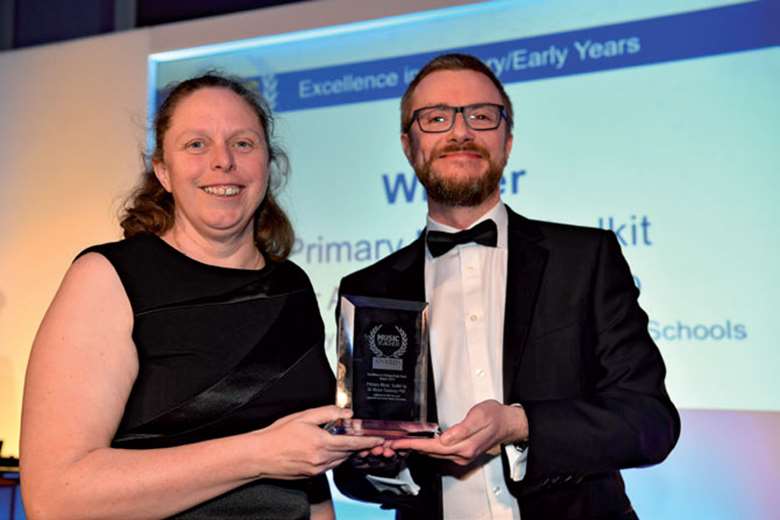ISM Column: Primary music toolkit
Alison Daubney
Wednesday, May 1, 2019
Pioneering music educator Alison Daubney writes for the Incorporated Society of Musicians about the Primary Music Toolkit, which won the Music Teacher Award for Excellence in Primary/Early Years 2019

The ISM Trust's Primary Music Toolkit, accessed by more than 6,000 teachers since its launch in 2017, was the first digital tool of its kind for non-specialist and specialist primary classroom music teachers. It was built with the everyday working teacher in mind, for mobile and tablets to provide easy accessibility for teachers while on the move.
Music teaching research repeatedly demonstrates that many primary school teachers feel underconfident to teach music. This is unsurprising when we consider that trainee teachers receive a pitiful amount of input relating to music teaching within their training year – if any at all. However, music is a compulsory subject in the National Curriculum, which still applies in the majority of primary schools in England and is integral to the ‘broad and balanced’ curriculum that Ofsted is clear it wants to see. We have a clear mandate from the government that this means it should be taught regularly as part of the curriculum. Indeed, as the former mayor of London Boris Johnson proclaimed when launching the London Music Pledge:
‘Music isn't a “nice-to-have” – it is an essential part of every child's education. From the ages of five to fourteen, all children are entitled to play instruments, compose and listen to music in school, every week. We should be hugely proud that the National Curriculum guarantees children ten years of unbroken musical learning in our schools.’
Sadly, we probably all know schools – both primary and secondary – where this is not the reality. We must find practical ways to support all primary teachers to feel more confident to teach music and help to embed music in the wider school culture.
In a bid to help primary school teachers to better understand what music teaching is and how it could be utilised even more to bring the primary curriculum to life, the ISM Trust, supported by the Schools Music Association, commissioned the development of a Primary Music Toolkit and made it freely available to download.
The toolkit comes in six downloadable parts, relating to:
- Setting up musical learning in the primary classroom;
- Leading and developing vocal work;
- A brief guide to using musical instruments;
- Composing and creativity – doodling with sound;
- Using technology in music primary education;
- Musical learning in the creative curriculum.
The point of the toolkit is to explore ideas about what primary music is and how teachers can gain confidence to lead inspiring musical experiences. It is packed with practical help, such as how to set up a classroom and ways to get musical instruments in and out, along with strategies to get attention back to you in a busy and productively noisy room, how to encourage creative exploration on instruments and technologies, and strategies for teaching a song. Fundamental points such as the pitch range of the song, counting in, giving the starting note and choosing appropriate repertoire are all considered.
It absolutely isn't about reinventing the wheel – it signposts other resources and ideas without promoting one method of music education over another. Instead, it is about promoting sound pedagogical ideas that can help teachers to plan inspiring music education. The toolkit sits alongside the guidance on planning, assessment and progression authored by myself and Martin Fautley.
The singing part of the toolkit is written collaboratively with Sing Up, the award-winning organisation with a wealth of experience in leading singing in primary schools across the country.
An example of the topics explored in the composing and creativity toolkit is given below:
- Composing and creativity – what do we mean by these terms? How ‘making’ and ‘creating’ music are integrally linked.
- How do we harness children's natural instinct to explore their sound world?
- The importance of ownership.
- Getting started – ways to encourage creative exploration in music/the importance of making choices and taking risks.
- Starting points – considering a range of ways to help children flourish as musical creators.
- Simple curriculum ideas for developing creative skills further at different stages of learning.
- Where else can you find material, suggestions and help?
The toolkit is overwhelmingly practical and many of the ideas embedded will help primary teachers to spread the magic of music through their inspiring curriculum and to permeate the cultural fabric of their schools.
Resources
-
Toolkit: ismtrust.org/primary-toolkit
-
Additional resources: ismtrust.org/resources
-
London Music Pledge: tinyurl.com/mt5-LMP

